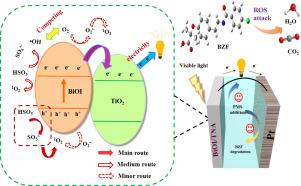Water Research ( IF 11.4 ) Pub Date : 2021-10-25 , DOI: 10.1016/j.watres.2021.117800 Xiangyu Chen 1 , Juanjuan Yao 1 , Hongsen Dong 1 , Mingjian Hong 1 , Naiyun Gao 2 , Zhi Zhang 1 , Wenchao Jiang 1

|
A collaborative system including peroxymonosulfate (PMS) activation in a photocatalytic fuel cell (PFC) with an BiOI/TiO2 nanotube arrays p-n type heterojunction as photoanode under visible light (PFC(BiOI/TNA)/PMS/vis system) was established. Xenon lamp was used as the light source of visible light. A 4.6 times higher pseudo-first-order bezafibrate (BZF) degradation rate constant was achieved in this system compared with the single PFC(BiOI/TNA)/vis system. The radical quenching experiments revealed that the contribution of reactive oxidative species (ROS) followed the order of 1O2 ≈ h+ >> •OH > SO4•− >>O2•−. The EPR tests demonstrated that PMS addition enlarged the formation of 1O2, •OH and SO4•−, but suppressed O2•− yield. Interestingly, 1O2 was further proved to dominantly originated from the priority reaction between positive photoinduced holes (h+) and negatively charged PMS. Besides, N2-purging tests and density functional theory calculation indicated that PMS probably reacted with residual photoinduced electron (e−) on the more negative conduction band (CB) of BiOI to form •OH and SO4•−, but competed with dissolved oxygen. Other e− transferred to the less negative CB of TNA through p-n junction will efficiently move to cathode through the external circuit. The greatly promoted power generation of PFC system was observed after PMS addition due to extra h+ consumption and efficient e− separation and transfer. Besides, three possible pathways for BZF degradation were proposed including hydroxylation, fibrate chain substituent and amino bond fracture. This study can provide new insights into the mechanisms of PMS assisted photocatalysis and accompanying energy recovery.
中文翻译:

通过可见光光催化燃料电池中的同步 PMS 活化增强苯扎贝特降解和发电
以BiOI/TiO 2纳米管阵列pn型异质结作为可见光下的光阳极,建立了包括过氧单硫酸盐(PMS)在光催化燃料电池(PFC)中活化的协同系统(PFC(BiOI/TNA)/PMS/vis系统)。氙灯被用作可见光的光源。与单一 PFC(BiOI/TNA)/vis 系统相比,该系统实现了 4.6 倍的伪一级苯扎贝特 (BZF) 降解速率常数。自由基淬灭实验表明,活性氧化物质 (ROS) 的贡献遵循1 O 2 ≈ h + >> •OH > SO 4 •- >>O 2 •-. EPR 测试表明,PMS 添加扩大了1 O 2、•OH 和 SO 4 •- 的形成,但抑制了 O 2 •-产率。有趣的是,进一步证明1 O 2主要源自正光致空穴 ( h + ) 和带负电的 PMS之间的优先反应。此外,N 2 -吹扫测试和密度泛函理论计算表明PMS可能与BiOI更负导带(CB)上的残余光生电子(e -)反应形成•OH和SO 4 •-,但与溶解氧竞争。其他通过 pn 结转移到 TNA 负值较小的 CB 的e -将通过外部电路有效地移动到阴极。由于额外的h +消耗和高效的e -分离和转移,在添加 PMS 后观察到 PFC 系统的发电量得到极大促进。此外,提出了三种可能的 BZF 降解途径,包括羟基化、贝特链取代和氨基键断裂。这项研究可以为 PMS 辅助光催化和伴随能量回收的机制提供新的见解。











































 京公网安备 11010802027423号
京公网安备 11010802027423号